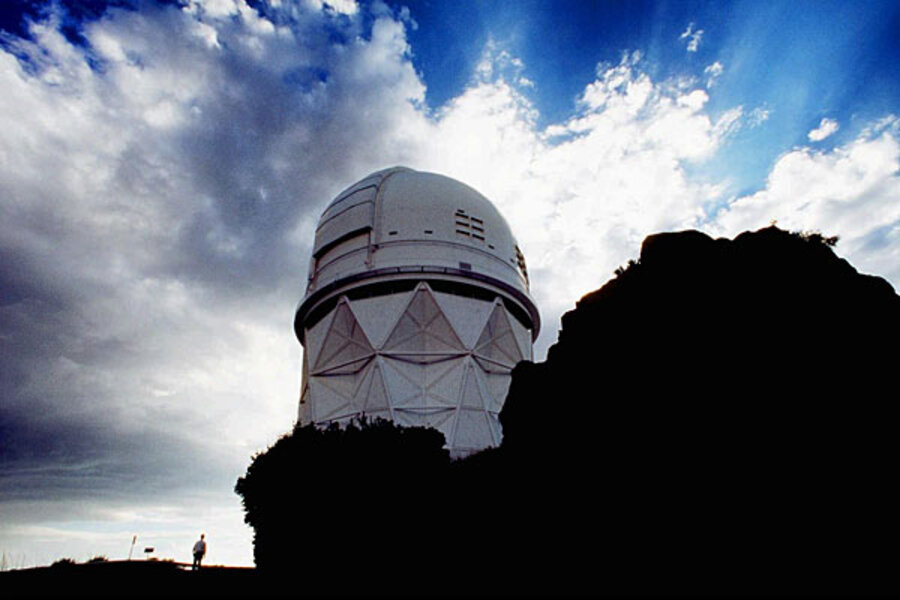Which telescopes could lose out in astronomy's big budget crunch?
Loading...
For astronomers in the United States it's déjà vu with a wrenching twist – the possible closure of some of the most heavily used observatories the federal government funds.
In 1995, the prospect of flat federal science budgets prompted calls to privatize or close workhorses such as the Kitt Peak Observatory near Tuscon, Ariz. That would ease the squeeze on other big-ticket observatory projects in the pipeline, the argument went.
Seventeen years later, telescopes at Kitt Peak, which avoided previous appointments with a broker, are again the budgetary bulls-eye.
This time the fiscal picture is far more bleak, and the projects in the pipeline are more ambitious. Thus, a panel advising the National Science Foundation (NSF) has recommended that the agency writing the checks for publicly supported observatories divest itself of six facilities as quickly as possible over the next four years.
The goal is to ensure enough federal research dollars to allow the US to participate in high-priority observatory projects through the end of the decade and have enough money left to supply research grants astronomers and their grad students need to use the new telescopes.
Aside from Kitt Peak's three largest telescopes, the divest-it list includes a gleaming white, 328-foot-diameter radio telescope at the National Radio Astronomy Observatory's Greenbank, W. Va., facility – dedicated 12 years ago and built at a cost of nearly $60 million. Four other scientifically productive telescopes or telescope arrays scopes are on the list as well.
Grappling with the issue wasn't easy, notes Debra Fischer, a Yale University astronomer who served on the advisory panel making the recommendations. Federally funded observatories serve as portals to the universe for a large number of astronomers who don't populate the faculties of universities with fiscal angels or pockets sufficiently deep to build their own observatories.
Still, "at the end of the day, I feel like we're protecting science for the next generation, even though it hurts right now," she says.
At their broadest, the recommendations reflect two fundamental but related changes in astronomy.
One is the move into what University of Wisconsin astronomer Jay Gallagher as well as others have called the era of "big science."
The easy questions about the birth and evolution of the universe from its grandest to its smallest scales have been answered. The remaining questions are tougher. They require bigger telescopes in space and on the ground to spot the most distant, hence fainest, objects. And they require increasingly sophisticated instruments bolted to the back ends of those telescopes to help astronomers convert that faint light into answers.
The bigger the telescope, the bigger the price tag.
As a result, "most of the world's major observatories are now international," says Dr. Gallagher, chairman of the university's astronomy department. Wisconsin, along with the University of Indiana, Yale University, and the NOAO, are the partners that built and run one of the telescopes on Kitt Peak the advisory panel has recommended the National Science Foundation shed.
The US is involved in several such collaborations, but international collaborations require strict budgets among partners over long periods of time – far longer than the annual US budget cycle. That can make these long-term commitments a budgetary vise, because the mismatched budget cycles make it difficult to make smooth adjustments in spending plans to accommodate new international projects.
The second factor is what some see as a decreasing need for an individual astronomer to have hands-on experience in running a telescope – experience many of today's top astronomers gained at facilities on the divestiture list. These days, astronomers often ride shotgun to telescope operators, who actually run the telescope and its instruments.
Perhaps more important, data increasingly are dumped into large repositories or "virtual observatories." There, researchers worldwide – and increasingly the general public taking part in citizen-science projects – pursue their own quests for discovery after an initial period where the scientist awarded time on the telescope gets first crack at analyzing the data.
This data-mining approach could represent a new way of doing astronomy, Dr. Fischer says, that reduces the need for travel to remote mountaintops for a large number of astronomers.
Keeping a robust astronomy program as part of the nation's science portfolio will not be easy, according to the advisory panel. But even recent attempts to keep the astronomy wish list grounded in fiscal reality didn't foresee the spending cuts in Congress and the White House are debating.
So the panel on Aug. 16 outlined two paths the NSF could take to supporting ground-based facilities, but both scenarios required immediate efforts to begin shedding the observatories the panel identified as divestiture candidates.
Divestiture doesn't necessarily mean an observatory would close, noted James Ulvestad, the NSF's director for astronomical sciences, during a briefing with reporters Aug. 17. The first option would be to find replacement partners, he said.
The NSF already has done this to varying degrees, he says. It turned the keys to a radio telescope on Kitt Peak over to the University of Arizona in the 1990s. And it currently has partners in some of the telescopes on the unload list. The WIYN telescope Gallagher's university shares is one of them.
"But the economic situation now is more difficult," he says, and not just for the NSF.
Universities are logical candidates, but they are strapped for cash as well, especially public universities.
Still, once the White House and Congress provide the final yea or nea on any divestiture plan, finding new partners to replace the NSF is Job No. 1.
"We fully intend to pursue those kinds of avenues vigorously before we go down any roads to closure," he says.








